College engineering technology team celebrates Capstone win
By Alejandra Pulido-Guzman - Lethbridge Herald on November 29, 2022.
 photo Courtesy ASET
Capstone project of the year winners Jeff Plowman, Scott Polec and Jaxson Kopp.
photo Courtesy ASET
Capstone project of the year winners Jeff Plowman, Scott Polec and Jaxson Kopp.LETHBRIDGE HERALDapulido@lethbridgeherald.com
A team of three former Lethbridge College Geomatics Engineering Technology students was recently recognized for their research project of a road network analysis of emergency services.
The students won the 2022 Capstone Project of the Year Award, given annually by the Association of Science and Engineering Technology Professionals of Alberta (ASET). The team consisted of Scott Polec, Jeff Plowman and Jaxson Kopp who graduated in 2022.
“We formed what is called a network analysis, so when you think of how far an ambulance can get, a lot of people like to think a radius around a fire station or hospital, and that’s not how it works,” said Polec.
He said a society is run are based on rules and laws and there are restrictions like roads.
“So instead of just creating a radius around a fire station, we used the roads and the speed of the roads to show how far can a fire truck drive following the standard laws, the speed limit to a place with a certain time frame,” said Polec.
Geomatics Engineering Technology instructor Tobi Baugh said their project was part of their second year research project and the team went above and beyond in their research.
“They didn’t just stop at one level or one major form of analysis, but they demonstrated multiple GIS tools and actually performed multiple analysis all in one data set,” said Baugh.
They had a road network data set that included speed limits, the amount of intersection stop signs which allowed them to test different scenarios.
“What if I had a fire in one location and the fire station that responded to it was located in somewhere else, what would be the most efficient route for them to take and how many minutes would that take,” said Baugh.
She said the team was able to map out all of Lethbridge of what is called service areas based on that road network analysis.
“That defines the service area that each fire station would most efficiently be able to respond to within a five-minute interval, and then you get a good idea of what areas of the city are better covered and what areas are lacking,” said Baugh.
She said they went a step forward as the population is not distributed evenly in Lethbridge, so they decided to do a population density analysis and then compared the service areas analysis in terms of population density.
“So, in terms of population density which populations are better served and least served,” said Baugh.
But they did not stop there, the team downloaded stats of fire incidents in the city over the last five years and they created what is called a hot spot analysis map.
“Based on that they could say okay so how well served is this particular hot spot by the existing fire station service area situation,” said Baugh.
She said the three students were great students and she hopes that this recognition sheds a light on the Geomatics Engineering Technology program, which seems like people are not very familiar with.
“Most people are familiar with the land surveying aspect of it, a very precise accurate measurement of the land, but then there’s the geospatial aspect as well and that’s the newer part that a lot of people don’t know about,” said Baugh.
She explained that is taking the measurements of the earth and then mapping them, analyzing them with other information and then crunching the statistics.
“What geomatics or geospatial is all about is keeping track of information, being able to map it and analyze it. Also being able to see patterns and trends so that you can predict into the future,” said Baugh.
Follow @APulidoHerald on Twitter
22-21


